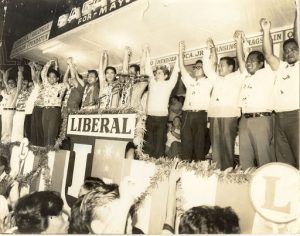1972 Martial Law: Ninoy Aquino, LP’s role cited
By: Former Senate President and Defense Minister Juan Ponce Enrile
MUCH of what had been said against the 1972 Martial Law was fiction. President Marcos became president of the country in 1965. The United States and the Soviet Union were locked in a bitter Cold War. And the communist ideology went on a rampage and set the world ablaze.
The Philippines was not spared. Two insurgencies were organized in the country in 1968. The CPP-NPA in Luzon and the Moro National Liberation Front (MNLF) in Mindanao. These insurgencies were on top of ongoing Datu Maffallen, Datu Mampatilan, Datu Mabalao, and Ilaga rebellions there.
Beyond these were also the heavily armed political warlords in many parts of the country. Such was the status of law and order in the land at that time.
The CPP-NPA and the Moro National Liberation Front were organized by three young men: Benigno “Ninoy” Aquino, Nur Misuari, and Jose Maria Sison. These three were former students in the University of the Philippines. They were allegedly supported by a country in East Asia that wanted to keep the Philippines busy.
The AFP then – which included the Philippine Constabulary – was a military force of some 48, 000 men and women. Its combat weapons were Cal. 30 M1 Garand and Cal. 30 M1 Carbine rifles that the United States used in World War II.
The CPP-NPA was armed with copies of Cal. 7.62mm U.S. M14 rifles, P-40 rocket launchers, mortars, and other lethal explosive devices imported from Red China. The MNLF was armed with modern European guns from Belgium.
The CPP-NPA and MNLF recruitments were quick and extensive. The CPP-NPA, for one, penetrated all sectors of society: youth, students, teachers, academe, colleges, universities, churches, professionals and intellectual groups, media, labor, farmers, fishermen, transport systems, urban and rural poor. Both also targeted the military for recruitment.
The NPA started its violence in Metro Manila and Central Luzon. Initially, its headquarters was in Hacienda Luisita in Tarlac.
It built a labyrinth of underground tunnels in the town of Capas. It terrorized the countryside and murdered those that resisted it. During the national election in 1969, about August or September, the NPA massacred twelve laborers in Barangay Sta. Lucia, outside of Clark Air Base.

In January, 1970, while President Marcos was delivering his SONA in Congress, the CPP barricaded the old Congress building on P. Burgos Street in Manila.
It trapped President Marcos, his family, Senators, Congressmen, Cabinet members, Supreme Court Justices, ambassadors, diplomats, other political and religious dignitaries, and leading business leaders inside the Congress building.
A day or two after, CPP elements stormed Malacañang, burned a hospital there, threatened the presidential residence; President Marcos had to evacuate his family to his presidential yacht in Manila Bay.
With the help of barrio self-defense units that it organized in Central Luzon, the AFP was able to dislodge the NPA from there. It pushed them north to Isabela in the Cagayan Valley. And from there the NPA spread to Region IV in the south to the Bicol region, to the Visayas Islands, and to Mindanao.
Meanwhile, in Metro Manila, the communists continued their destructive work. First, they bombed the Joint US Military Advisory Group (JUSMAG) headquarters in Quezon City.

They bombed the Liberal Party rally at Plaza Miranda during the political campaign in August, 1971. Several people were killed. Many were injured. Senator Jovito Salonga, among others, suffered severe wounds on different parts of his body. He nearly became blind.
From 1970 to 1972, Metropolitan Manila suffered weekly bombing. The communist insurgents bombed oil firms, pipelines of water utilities, Meralco electric power systems, public and private buildings, business structures, public and private markets. Even the US Embassy was not spared. So were the Food Terminal Market, the Arca Building, the Filipinas Orient Airways, the Court of Industrial Relations, the Philippine-American Life Insurance Company, to mention some of many.
Massive labor and transport strikes were mounted. The communists tried to isolate and paralyze Metro-Manila (SLEX and NLEX were not yet existing then).
One of the transport strikes created a traffic jam that stretched from Los Baños in Laguna to Manila.
The communists also captured UP Diliman in Quezon City. They established a Communist Commune there under Erickson Baculinao as Chairman. For several weeks UP Diliman was off limits. No one could go in and out of the place. Permission from the Commune was required. UP President Salvador Lopez became a virtual prisoner in his university. One person was shot and killed in that incident.
In July, 1972, Defense Minister General Maraden Panggabean of Indonesia was my official guest in Manila. When he observed what was going on in the country, he said in one of our conversations:
“You know, Johnny, what I noticed about your country reminds of what happened to us in Indonesia during the communist trouble there. Be careful!”
The final straw that broke the camel’s back came from Ninoy Aquino himself. In August, 1972, Ninoy asked me for an urgent meeting. I met him in Urdaneta Village in Makati in the house of Ramon Siy Lay, our common friend. His brother Paul Aquino was with him.
He told me that he met leaders of the CPP, and they discussed a coalition between the CPP and the Liberal Party should President Marcos declare Martial Law.
I made a written report of that meeting to President Marcos. When President Marcos informed the public about what I reported to him, Ninoy denied that he met me.
President Marcos invited the Liberal Party leaders to Malacañang for a meeting with him, but the Liberal Party leaders refused to attend. This incident made up the mind of President Marcos. History was made. He proclaimed Martial Law throughout the land.



